Bookwalter, Meister & Weber: Studio Conversations
July 21 – August 28, 2015
Closing Reception: Wednesday, August 26, 2015, 5 pm. to 7 p.m.
University of St. Francis Gallery
25 East Van Buren Street, Joliet, Illinois, 60432
An Artist’s Conversation and Interview:
Studio Conversations: Inviting Comments & Drawing Conclusions: A collaboration between Mary Bookwalter, Janice Meister & Carol Weber
Robert Rouschenberg and Jasper Johns did it. Man Ray and Lee Miller did it. So did Matthew Barney and Björk. Collaboration in art is as old as Art itself.
Collaboration in art is the ultimate test of placing your ego aside in order to work toward a common idea. The image of the ego driven artist may be somewhat stereotypical – but I’d say that there is some truth in suggesting that most artists find it difficult to invite other artists into their process directly. The creation of art is a private affair for the majority of artists I’ve known over the years. Not all are open to the idea of sharing an artistic vision in that manner.
But for Bookwalter, Meister and Weber, the idea of collaboration and the act itself was an opportunity to expand horizons and create a body of work that spoke less of solidarity and more to the concept of growing and learning as an artist. Each artist managed to create works that remain true to themselves while gaining valuable experience working on a unique collaboration.
Q&A
JM – Janice Meister
CW- Carol Weber
MB – Mary Bookwalter
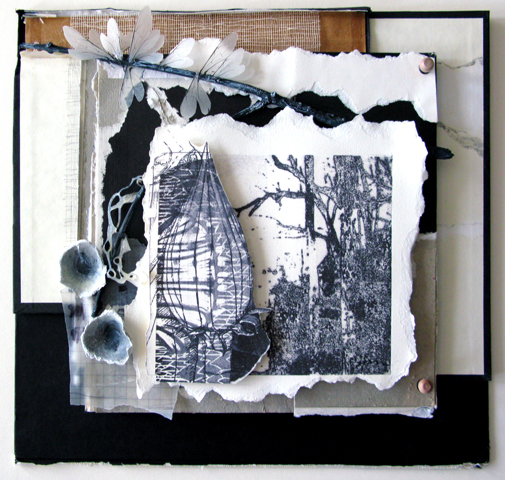
Janice Meister, White Tea Series, Monoprint Construction
How long have you been practicing art?
JM: Well since I was 2 years old (non credentials) since 1972 with credentials.
CW: I decided “for sure” in the 3rd grade that I wanted to be an artist. I have stayed on that path ever since that monumental decision.
MB: From the time I was seven my mother encouraged me to draw and “paint”. She bought me a box of outline drawings of birds and the Prang 12 color box of watercolor pans. I didn’t know I was “making art”, I thought I was just making pictures. This was pre-paint by number. Those were very colorful birds.
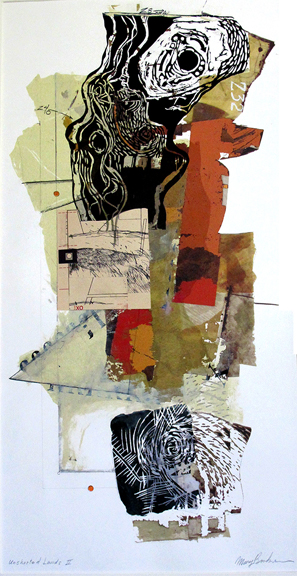
Mary Bookwalter, Uncharted Lands II, Mixed print and drawing media
What is/are your primary medium or mediums?
JM: Printmaking, drawing, mixed media… actually I take prints violate the sanctity of the original by using it in a mixed media construction/collage. Often each work is derived from nature and contrived by trial and error with intent to manifest a mood, place, or carry a message inspired by a word, poem etc.
CW: I started in painting and drawing. That progressed into mixed media and then constructed works. I would say my primary medium is mixed media.
MB: In high school and undergraduate I was a painter. This was 1962 and acrylic had just hit the market. There was the big divide between the oil painters and the acrylic painters. But in my senior year I took two printmaking classes and fell in love with the process. I am lucky to have had a couple of great teachers who made learning exciting and challenging. To this day I consider myself a printmaker and I draw all the time in my sketchbooks.
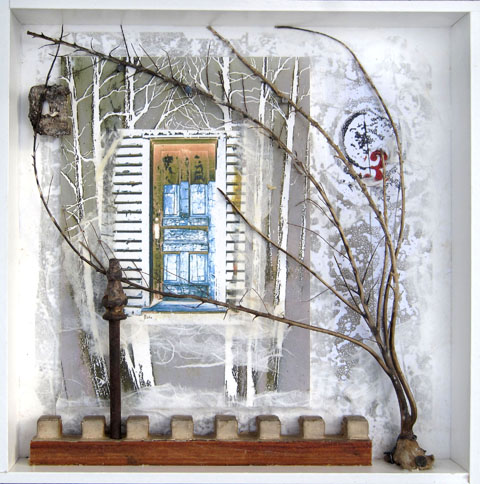
Carol Weber, Slightly Veiled Mysteries, Mixed media
Is this your first collaboration with another artist?
JM: No, I have completed one or two more series of works with other artists and art educator/students in the past.
CW: No. I did a show with a group of artists from Rockford Illinois. In that collaboration each artist started a piece and we passed work from one artist on to the next, each adding or taking away from what was passed on to us.
MB: No. I participated in several other cooperative adventures. One was with a group of artist friends in Waverly, Iowa where I taught high school. We each began a drawing, put it in a manila envelope and mailed it on to the next on the list. We started with six artists, and ended up 6 weeks later with about twelve. Of course we couldn’t resist drawing on the envelopes too. We did get a notice from the Waverly P. O. to NOT obscure addresses and to place stamps correctly. I’d like to do that again. A first small act of civil disobedience. I also worked with an artist from New Mexico and a small group if others in producing pages for a handmade book, based on a theme of mapping our travels.
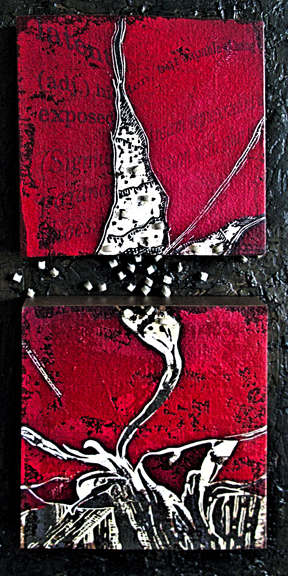
Janice Meister, Latent -Hidden but Capable of Being Exposed, Mixed media, monoprint construction; handmade tobacco paper, birch
When did you begin working on this collaboration?
JM: (Studio Conversations – started as a threesome in 2011) actually Mary Carol and myself have always shared studio discussions, encouraged supportive dialogue and helped one another by networking our knowledge, insights, resources, contacts… family affair!
CW: I believe it was 2011.
MB: Studio Conversations began in 2011. Jan, Carol and I had a show scheduled at 33 Contemporary. We started with a lot of ideas and very little direction.
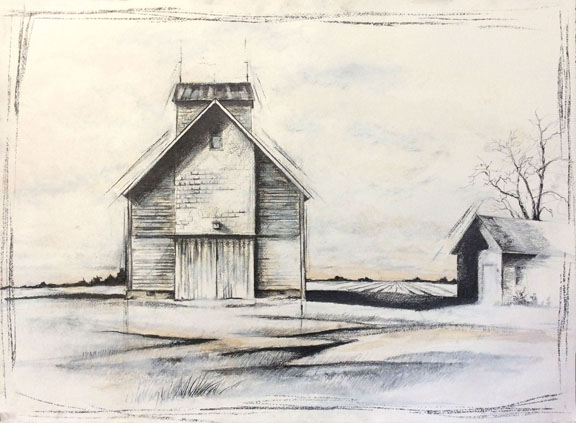
Carol Weber,In Your Shadow, Graphite, pencil and coffee
What prompted you to work together?
JM: A respect for our professional experience and gained expertise with materials, techniques and the ability to not feel envy or fear or jealousy for each other’s achievements… matter a fact we have always respected our personal growth and collective achievements.
CW: We had talked about doing a show together. We all knew that our work would make a cohesive exhibit but we wanted it to be something more than a collection of our individual works. We also knew we wanted to experiment and to interact with each other in a way we hadn’t done before.
MB: We knew we could work together, there was mutual respect and admiration for each other personally, but I think over all we wanted to do a show that was “different” than what others in the 33 group had attempted. We had long discussed our art, sort a grown up “show and tell”. This was a chance to put our work together and display our common commitments.
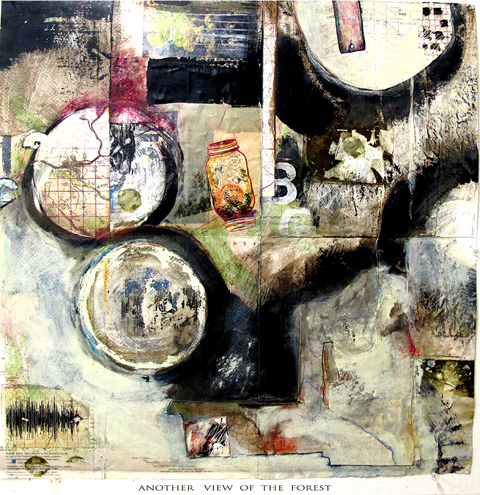
Mary Bookwalter, Another View of the Forest, Mixed media
Explain what you wanted your work, shown together, to say or explain.
JM: That art is a dialogue for the viewer, the professional colleague and the critic to examine, and digest as a shared experience that an artist or artists often have when they are seeking to make art for themselves and others.
CW: That’s a difficult question to answer because I’m not sure we had a clear idea of the outcome when we started. I wanted to express the idea of experimentation at any level on one’s career.
MB: Good question, that’s what we were asking each other. And it took a while to work through how we could combine our various styles and individual strengths without becoming repetitive and /or too controlling. I didn’t want to combine our artwork per se but to blend our thought processes and our desire to communally experiment. There had to be a cohesive element for the viewer to explore, not three separate exhibitions. That was a fun pot to stir.
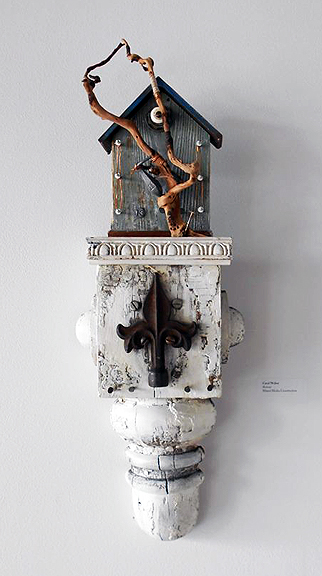
Carol Weber, mixed media construction
Obviously not all art collaborations are the same. Can you explain the process of this collaboration and how each of you decided what it would entail?
JM: We really consider our sharing a Conversation that produces an ability to create on an individual basis. We share, talk, problem solve, debate the pro’s and con’s of a material, an idea, a technique, an approach… whatever we bring to the discussion. We talk regularly – an art intervention if need be or an art celebration when outstanding events occur or are designed. Share, share, share, laugh, share, share, share and ultimately support.
CW: We started by talking about how this collaboration would be a different experience for each of us. We wanted to have more interaction with each other during the process of art making. Often artists only talk about their ideas after the work is completed. What made sense to all of us after hashing over a number of ideas was the idea of starting with a common denominator. The result is the grid work, the house panels, and the pieces framed together. The small grid works have been an element in all of our exhibits and I think we all enjoy those little pieces immensely.
MB: It started with discussion, asking questions, reviewing each person’s current work, and looking for the underlying themes that could hold the show together. We tried to get a sense of what different sections of the exhibition would look like, what media, scale, color, and composition would impart the visual impact we wanted to achieve.
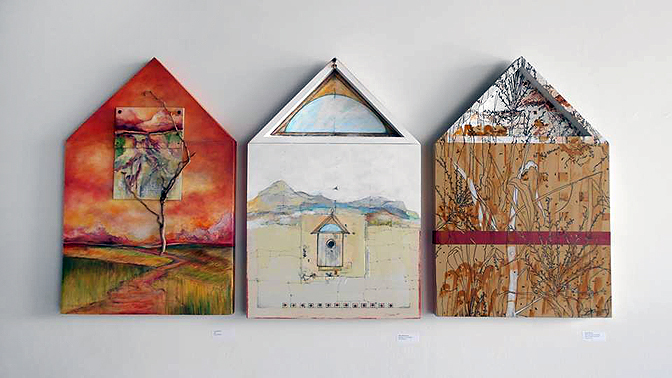
Works by Carol Weber, Mary Bookwalter, and Janice Meister
Your work stems from the collaboration of ideas as opposed to creating a single artwork (an exquisite corpse approach). Can you explain why you decided to work together in this capacity?
JM: Respect for individuality.
CW: We wanted to keep our individuality and to learn from each other. I live a distance away from Mary and Jan, so working on the same pieces wasn’t practical. We all work in different ways, at different speeds, even different times of day. We had to find our own way of collaboration because the traditional idea just wouldn’t work for us.
MB: We attempted a piece in which we each designed and executed a section of the whole. We struggled with this idea. I think we all were all being “nice” about the “combination” idea. We soon found out that “pushing the river” always causes confusion and that trusting one’s own instinct prevails.
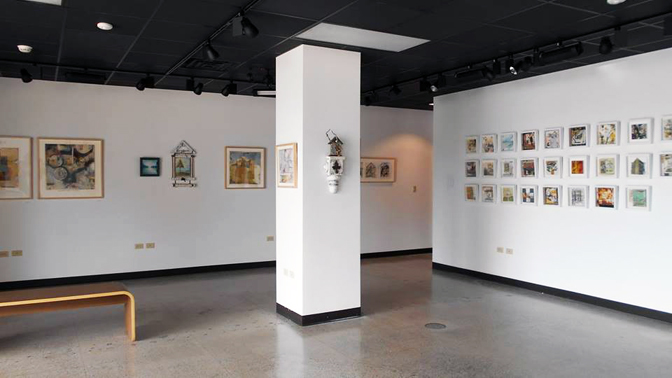
View of Studio Conversations at the University of St. Francis Gallery, Joliet, Illinois, 2015
The image of the ego driven artist may be somewhat stereotypical — but I’d say that there is some truth in suggesting that most artists find it difficult to invite other artists into their process directly. How did you deal with that?
JM: We all have the luxury of being educators, each of us have taught art for years… inspired others, coached aesthetic outcomes and made art with others. Each of us have fought with apathy, ego and depressed flow. Each of us has enjoyed the “break-through” moment from our students and have honed our sharing skills to a razor sharp “AH HA” So Share has never been an issue… time is the most difficult issue we face, time to share, time to learn from one another and time to reinvent, reignite and regain our collective energy.
CW: We have been friends a long time and admired each other’s work. We all have been educators, so the value of learning and growing together seemed refreshing. I was excited to learn in detail some of the methods and materials Jan and Mary were using. I also wanted to bring something valuable to the mix. The challenges and the excitement to be part of this far outweighed the sense of ego.
MB: We all have very much in common; we trust each other and care about each other. Also, we have each worked as educators and are used to working with students, other artists and faculty, multiple processes and ways of interacting. Confidence and the desire and ability to share your ideas with others outweighs ego.
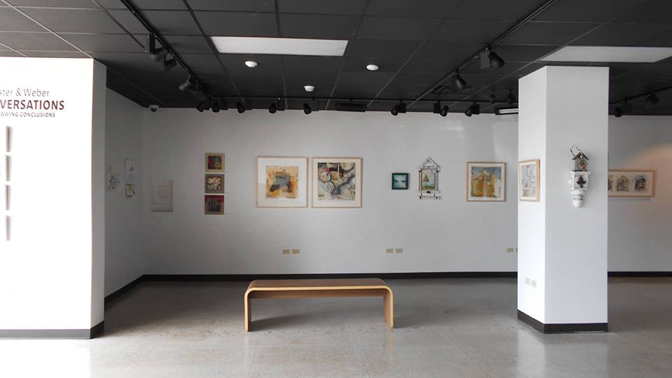
View of Studio Conversations at the University of St. Francis Gallery, Joliet, Illinois, 2015
For those who may have never tried a collaboration, we tend to conjure up romantic notions of the process. Was the process always easy or were there some difficult hurdles to overcome?
JM: Nothing worth doing is easy… especially if you are compounding the outcome. We often talk about the beginning of our conversation, the idea of “how do we gain a connection to one another, where is the flow? The complete “meal” will have to be a digestion of many visual flavors.
CW: There are always hurdles. Some of ours came in deciding how to collaborate. It was also challenging to describe our concept of the collaborative process. We have an incredible respect for each other, so if one of us didn’t like an idea we dropped it. It wasn’t a majority rules method.
MB: Oh yes, there were some hurdles but one deals with problems everyday as a part of life. I think the process of working together is always a learning one, and a rewarding one. Sometimes you need to try a different approach, just walk down a different path.
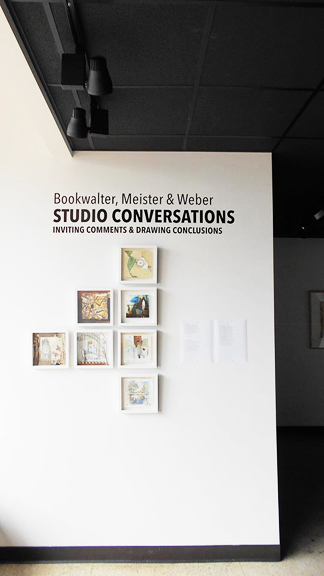
View of Studio Conversations at the University of St. Francis Gallery, Joliet, Illinois, 2015
Which part or parts of the collaboration did you find most refreshing?
JM: The consistent learning from one-another and about one-another. The acknowledgement of each other’s strengths and mutual excitement about helping each other see, when we are blinded by our personal confusion… about, with or in our art making.
CW: The conversations!
MB: The get-together talks, seeing new work the others were doing. Showing my work and getting feedback from Jan and Carol. The conversations were not “work sessions”, they were a chance to see and communicate with my friends about art.
How did the collaboration affect your own art?
JM: This collaboration has made me more adventurous with media, materials and techniques.
CW: I have some different materials and methods to use. I have input on my work that I value. Some of the feedback I got on my work during our conversations helped me see my strengths and this helped with the direction of my recent work.
MB: I have begun to add painting again into my work and to look at other media and methods more seriously. In the past I have touched on bookarts and alternative photography; I would like to again add these processes to my work.
Has the collaboration affected your philosophy regarding what art is or can be?
JM: Not really, I have always thought that “breaking established norms/rules was the purpose of an art adventure. That any philosophy is evolving from all kinds of life…
CW: I think artists do need a sense of community, even if that community is a small group of close friends. Working in isolation isn’t enough for me and I think it isn’t enough for most artists
MB: Yes, I think I am more apt to be receptive to viewing, searching out, and reading about styles and methodology that I have passed over or not found of interest before. Overall, I have made some changes about how I think about art. I am more receptive to different views.
How do you see the other artist’s work differing from yours in this group?
JM: Well, that’s a good question… each of us has an individual signature, a trace that comes through and separates us- even though out work may hang close together. Each work of art has that signature. It may be Mary’s use of color and quality of line. It may be Carol’s subtle use of architectural structure or array of value. In terms of elements and universal principles each of us leans heavily on a line, a shape, a value, an approach. While the other uses a different tangible dialogue with the sub straight.
CW: We all have an acute awareness of formal elements, but we have our own signature styles. Our themes have much in common. I personally admire Jan’s rich surface textures and Mary’s exquisite line and nuanced colors.
MB: Visually there are many differences in our work, we each have a developed style and structure although we share many similar themes in the work. Together we all share strong values concerning the importance nature and employ a strong work ethic. I especially like Jan’s textural work, the abandonment with how she works, and makes it all beautifully come together. I envy Carol’s sense of space in laying out drawings which are some of the best I have ever seen.
Would you recommend other artists working collaboratively? Can you give a few words of advice for artists considering a collaboration?
JM: Be open minded and make lots of mistakes… remember not to discard your attempts and revisit your work often and allow your co conspirators to sling those bows and arrows of advice.I think that collective reasoning on the visual level is natural. Just do it and see what happens for you the artist.
CW: It’s a valuable learning process. You need to have an idea why you are joining collaboration – what you hope to gain from the experience; I recommend it as a way of pushing past some self imposed boundaries.
MB: Yes, I definitely recommend it. First, choose carefully with whom you will be working. That can make all the difference. Be open to new ideas and leave your artist ego in your studio. Be ready to share as well as learn. Enjoy yourself in this process; you will be a better person, and artist, for it.
Organized and curated by Jennifer Moore, University of St. Francis, Gallery Director


